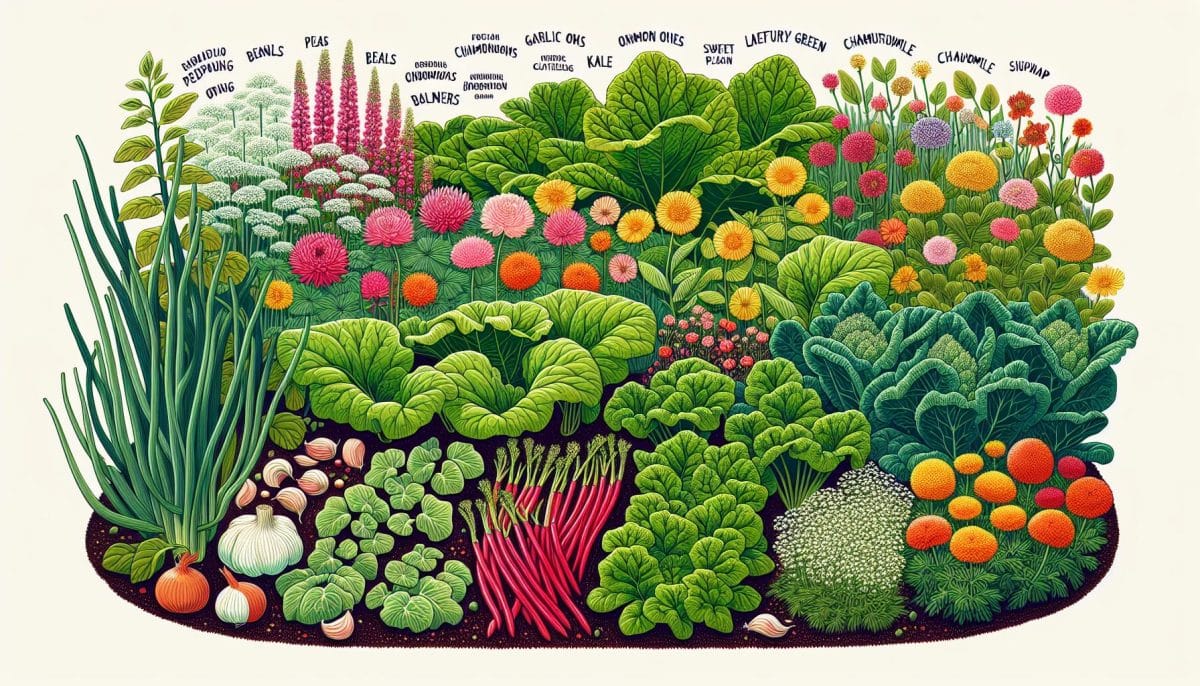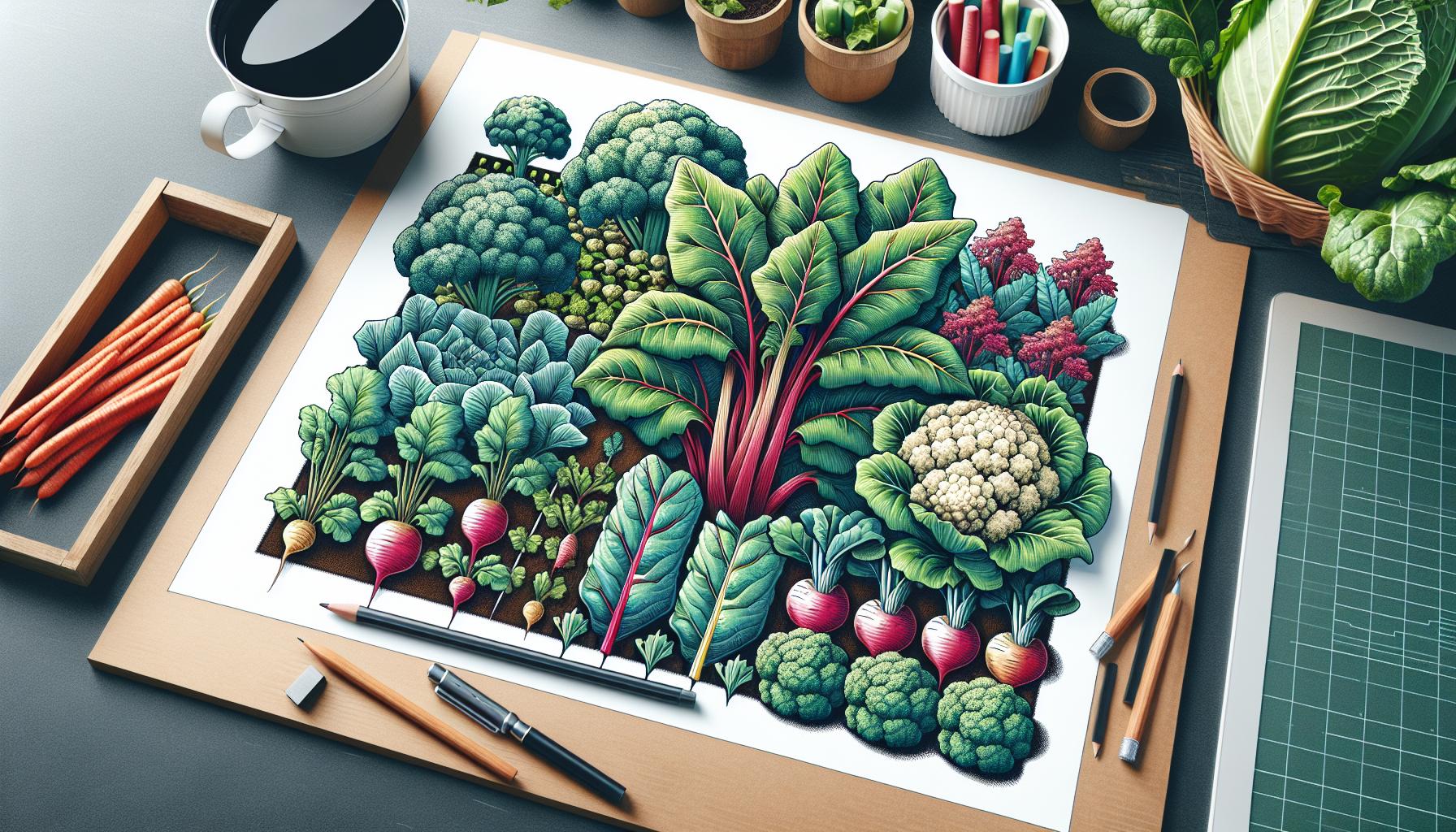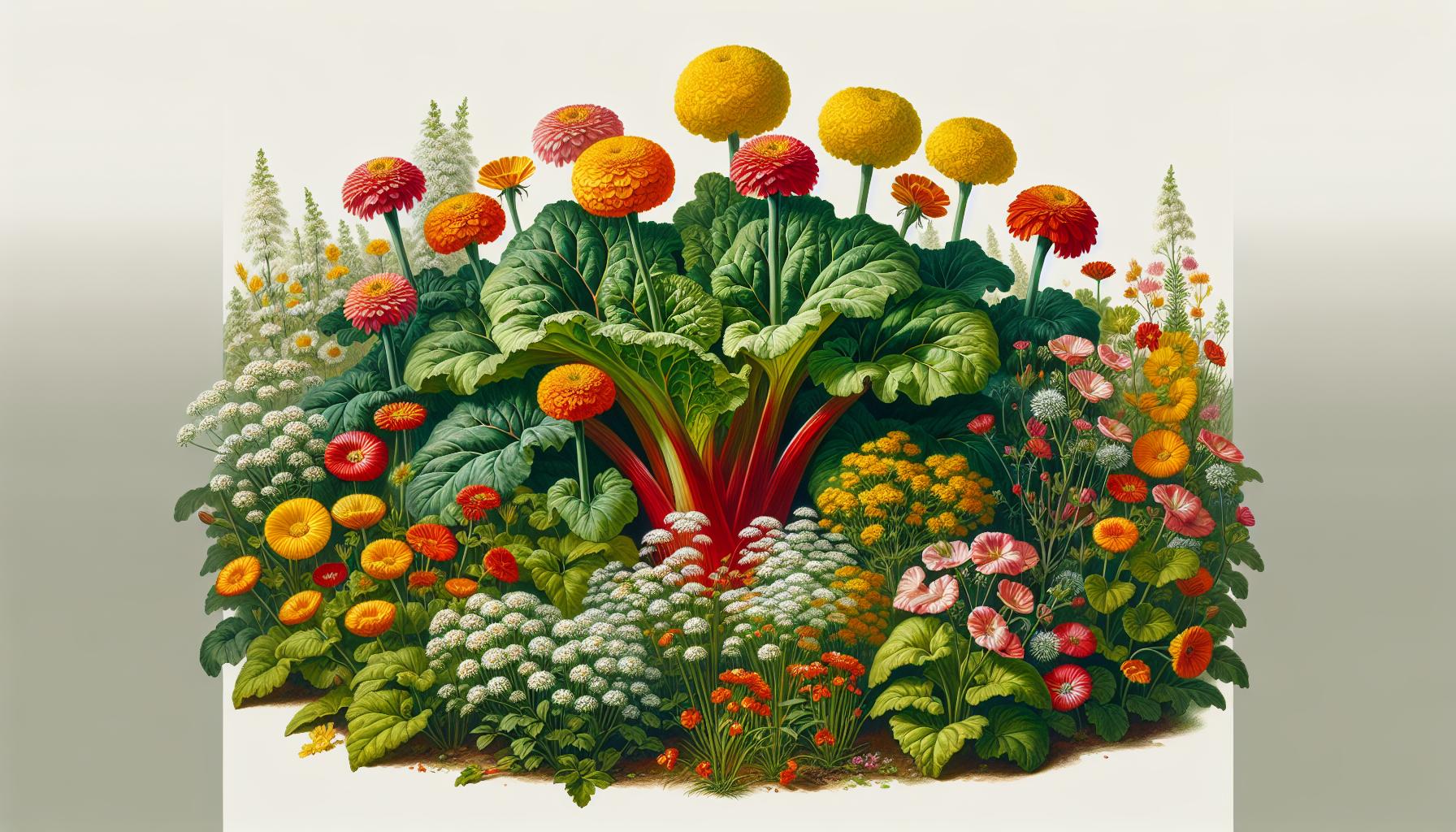
Growing rhubarb in your garden offers more than just a harvest of tart, versatile stalks—it’s also a chance to boost your garden’s health and yield. By pairing rhubarb with the right companion plants, you’re setting the stage for a symphony of growth where each plant benefits the others. Let’s dig into the best companions for your rhubarb and why they’re such a great match.
Companion planting is a savvy gardener’s strategy to enhance growth, deter pests, and maximise space. With rhubarb, selecting companions isn’t just about compatibility; it’s about creating a thriving ecosystem right in your backyard. Ready to find out which plants make the best neighbours for your rhubarb patch? Keep reading to unlock the secrets of companion planting with this culinary favourite.
Benefits of companion planting with rhubarb
When you integrate rhubarb into your garden alongside compatible companion plants, you not only enrich the ecosystem but also gain a myriad of benefits.
- Enhanced Growth: Certain plants when grown next to rhubarb can actually improve its overall growth. For example, garlic has been noted to promote the vigor of rhubarb plants.
- Natural Pest Deterrence: Growing aromatic companions such as onions nearby can naturally ward off pests. This is because the strong scents act as a deterrent, reducing the need for chemical pesticides and keeping your rhubarb healthier.
- Improved Soil Health: Legumes planted in proximity to your rhubarb can fix nitrogen in the soil. This process enriches the soil, so supporting rhubarb’s growth as it thrives in nutrient-rich conditions.
- Mutual Protection: Tall plants like sunflowers can act as natural shields for rhubarb, offering shade from intense sunlight and protection from wind.
- Optimized Space: Using companion planting allows you to make the most of your garden space. This is especially beneficial if space is limited, as you can grow rhubarb alongside plants that have different height profiles, preventing overcrowding and ensuring all plants have adequate space to thrive.
By understanding the specific interactions and benefits that each companion plant brings, you can create a harmonious and productive garden space. Remember, the goal is to select companions that will form a symbiotic relationship with your rhubarb, leading to a prolific garden.
Choosing the right companion plants for rhubarb

When selecting companion plants for your rhubarb, it’s essential to consider those that offer tangible benefits to this perennial vegetable. Legumes such as beans and peas are excellent choices; they fix nitrogen in the soil, which rhubarb plants crave for their growth. Not only do legumes support rhubarb with needed nutrients, but their vertical growth habit also maximises the use of space in your garden.
Besides, garlic and onions are known to repel rhubarb pests, such as aphids and fruit flies, acting as natural pest control. Planting these alliums nearby can lead to healthier rhubarb plants with lower incidence of pest damage.
Incorporating leafy greens like kale and spinach can be beneficial as well. These companions create a living mulch, keeping the soil cool and moist, conditions that rhubarb thrives in. Plus, they can be harvested regularly, which encourages air circulation and reduces the risk of fungal diseases around your rhubarb plants.
Remember to avoid planting companions that compete heavily for nutrients. Avoid cruciferous vegetables like broccoli and cauliflower, as they can stunt rhubarb’s growth by creating a resource rivalry.
When planning your garden, you can aim to plant annuals around rhubarb. Rotating these companion plants yearly helps prevent soil depletion and keeps your rhubarb thriving season after season. By carefully selecting the right companions, you’ll foster a garden ecosystem that supports robust growth and minimizes issues, without the need for chemicals.
Planting herbs with rhubarb

When integrating herbs into your rhubarb garden, you’re performing a strategic act of plant synergy. Certain herbs can enhance rhubarb growth and even improve the flavor of your fruits and vegetables. Considering the aromatic nature of herbs, they are excellent for pest control, a benefit that rhubarb particularly enjoys.
Chives, for instance, when planted nearby, may enhance the growth and flavor of rhubarb stalks. The strong odor of chives is known to deter pests, making them less likely to invade your rhubarb. Similarly, mint serves a dual purpose; its vigorous growth habit can help to suppress weeds and its strong scent is reputed to ward off several pests that might otherwise be attracted to your garden.
Another herb, oregano, is famed for its robust aroma and is believed to repel a variety of insects that could harm rhubarb plants. It’s a low-maintenance herb that, once established, provides ground cover and reduces the need for frequent weeding.
Planning your herb placement is crucial as you don’t want them to overshadow your rhubarb in terms of space and nutrients. Mint, particularly, should be planted with caution as it can become invasive. Using containers or designated areas can ensure the mutual prosperity of both rhubarb and your chosen herbs.
- Chives: Enhance rhubarb growth and flavor, deter pests
- Mint: Suppresses weeds, repels pests, caution against invasiveness
- Oregano: Repels insects, provides ground cover, low-maintenance
By wisely selecting and positioning your herbs, you create a healthy ecosystem that promotes better growth and minimizes the risk of disease. This natural form of planting management enriches your garden without relying on harsh chemicals, thereby preserving the integrity and safety of your harvest.
Planting vegetables with rhubarb

When you’re aiming to ensure maximum productivity in your garden, incorporating vegetables alongside your rhubarb is strategic. Certain veggies do more than just save space; they contribute to a synergistic environment that promotes health and growth.
Brassicas — such as broccoli, cabbage, and cauliflower — are excellent when planted near rhubarb. These plants are known to benefit from the high levels of calcium rhubarb leaves deposit into the soil as they decompose. Also, rhubarb’s large leaves provide shade for these cool-season crops, reducing the stress of summer heat.
Even root vegetables like beets and carrots can prosper beside rhubarb. The deep roots of these vegetables do not compete with rhubarb’s shallower system, ensuring they can coexist without hindering each other’s access to nutrients and water. Consider the timing when you introduce vegetables to your rhubarb patch. Interspersing young vegetable plants among mature rhubarb ensures that they don’t interfere with rhubarb’s early growth stages. This strategy paves the way for primary rhubarb development while still maximizing your garden’s yield.
On the other hand, proximity to rhubarb can deter specific pests, such as the whitefly, often problematic for a range of vegetable plants. Rhubarb’s robust presence can act as a natural repellent, reducing the reliance on pesticides and fostering an organic gardening approach.
Planting vegetables with rhubarb isn’t just about saving space. It’s about creating a thriving garden ecosystem that supports both the growth and protection of your plants. By making judicious choices about which vegetables to pair with rhubarb, you’re setting the stage for a robust, sustainable garden.
Flowers that thrive alongside rhubarb

Integrating flowers in your garden not only adds aesthetic value but can also augment the health and vigour of your rhubarb plants. Certain flowers when planted near rhubarb provide mutual benefits and can enhance biodiversity, attracting pollinators and beneficial insects.
Marigolds, for instance, are a garden favourite. Renowned for their pest-repellent properties, marigolds exude a substance from their roots that deters nematodes, which might otherwise harm your rhubarb. Their bright orange and yellow blossoms also attract pollinators, vital for the fruiting of many other plants in your garden.
Another companion flower to consider is nasturtiums. With their vibrant colours and easy-to-grow nature, nasturtiums serve a dual purpose. They not only lure aphids away from your valued crops but also are edible themselves, making them a practical and decorative choice.
Planting chamomile near your rhubarb can have surprising benefits. Chamomile is believed to improve flavour and stimulate growth in nearby plants due to its high levels of calcium. It’s a light, airy flower that won’t overshadow your rhubarb but will bring a gentle, daisy-like beauty to your garden composition.
Sweet Alyssum is another great companion, forming a living carpet that suppresses weeds and conserves soil moisture. The delicate fragrance of its tiny flowers draws in beneficial insects that prey on common garden pests.
By introducing these flowers into your rhubarb patch, you’re not only diversifying your garden but also establishing a natural defence system against pests. Besides, these plants will help to create a visually appealing space that supports the ecosystem’s balance. Choose flower companions for your rhubarb that are not only beautiful but functional, ensuring a bountiful and healthy garden.
Conclusion
Embracing companion planting will elevate your gardening game, particularly when it comes to nurturing rhubarb. By partnering rhubarb with legumes, garlic, onions, leafy greens, and specific flowers, you’re not just growing plants side by side – you’re fostering a symbiotic environment where each species thrives. Whether it’s fixing nitrogen in the soil, repelling pests, or attracting beneficial insects, these companions work in harmony to ensure your rhubarb is healthy and productive. So go ahead, enrich your garden with these companions, and watch as your rhubarb – and garden as a whole – flourishes.
Colin Macmillan is a seasoned entrepreneur and the CEO of Riverwood Landscape, a leading landscaping company based in Canada. He has been at the helm of the company since leaving high school, demonstrating his strong leadership skills and business acumen.
Colin’s expertise lies in various aspects of landscaping, including lawn care, interlocking, sod installation, and commercial maintenance. His hands-on approach and dedication to the craft have been instrumental in building Riverwood Landscape into a reputable brand.
One of his most notable achievements is the creation of a successful landscape franchise that services multiple locations. This accomplishment underscores his strategic thinking and ability to scale operations effectively.
Colin has also had the privilege of working with Guelph Hospital for landscaping and maintenance, a testament to the trust and reliability that his company has earned over the years.
His professional mission is to offer the best services and experiences for customers, a goal that he tirelessly pursues. Colin’s commitment to excellence and customer satisfaction continues to drive the growth and success of Riverwood Landscape.








